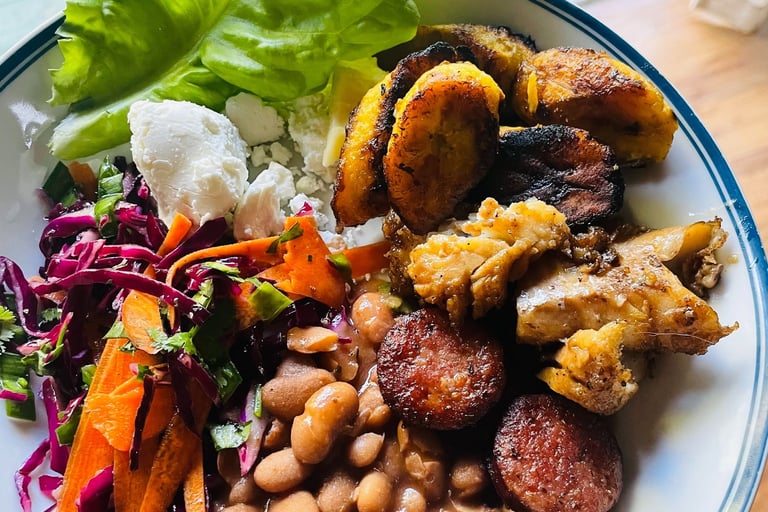The Lost Art of Soaking
The missing link in many healthy diets
RECIPESBEANSFOOD PREP
Eileen Brantley
6/23/20253 min read


A lot of us in the holistic health space avoid legumes, grains, and nuts because we fear their anti-nutrients, enzyme inhibitors, and potential to damage our gut lining. Maybe we’ve found relief from the paleo or AIP diet, maybe we just hate the way our bellies bloat after beans and rice.
But maybe the issue isn’t the food itself but the lost art of proper food preparation.
The age-old technique of soaking grains, legumes, nuts, & seeds has gotten lost in the hustle-bustle of modern life, but there is a growing wealth of science-driven information confirming the efficacy of traditional wisdom. Soaking takes time, but it takes away years of pesky digestive and immune issues that might be rooted in improper food preparation.
Unpacking Anti-nutrients
All plants possess compounds collectively called “anti-nutrients” and for good reason-found in the outer layer of virtually all seeds, nuts, grains, and legumes, they intelligently protect a plant from predation and degradation.
One example of anti-nutrients are phytates. Phytates inhibit absorption of minerals like zinc, iron, calcium, magnesium, manganese, and copper and abound in processed foods that disregard proper food preparation techniques and instead exponentialize phytate concentrations. For example, one study of 36 common grain products confirmed consistently high phytate levels in processed cereal- and legume- based products (Roos et al, 2013). Additionally, the popular pseudo-grain quinoa’s bitter outer kernel is especially high in saponins and protease inhibitors which can cause gastrointestinal distress and inflammation.
For example, one study found significant reductions in common anti-nutrients such as oxalates, lectins, tannins, saponins, and enzyme inhibitors by the simple act of presoaking grains (Shi et al, 2019).
Traditional food prep takes a bit of forethought, but that is the most difficult part. Once you get into the habit of soaking, it becomes second nature. In fact, I have found that my transition into a more ancestral way of cooking has made me more organized and thoughtful. Ancestral wisdom in the kitchen gives you the skills to flawlessly meal-plan and prep, eliminating food waste and aligning you with the natural rhythms. Best part - it doesn’t really require exact measurements - just eyeballs!
BASIC FORMULA for GRAINS, LEGUMES, & PSEUDO-GRAINS
Rinse your grains/legumes/pseudo-grains
Cover completely with filtered water
Add ~1-2 tbsp lemon juice or vinegar for every c of dried grains/legumes/pseudo-grains*
Let soak for 8-24 hr (8 for white rice is sufficient but for heftier beans, longer is ideal)
Drain, rinse, and add to a pot. Add enough filtered water or broth to cover by ~½-1 inch. Add a hefty pinch of sea salt and fresh herbs & garlic to taste.
Cover, bring to a boil, reduce to a simmer, and let simmer away with a lid halfway on until the water has evaporated and the grains/legumes/pseudograins are tender and tasty**.
At this point I like to stir in butter or olive oil and more sea salt and pepper/seasoing to taste.
BASIC FORMULA for NUTS & SEEDS
Preheat oven to 200-250 F (higher for bigger nuts, lower for smaller nuts/seedS)
Follow steps 1-4 above
Drain, rinse and add to a sheet pan. Liberally sprinkle with sea salt and other desired seasoning (cumin, chile, cinnamon are favorites)
Bake at 200-250 F for 1-4 hr, depending on size of nut/seed and temp chosen. For example, walnuts take ~2 hrs at 230 F. You’ll need to check & taste regularly to find your desired texture
Turn oven off but leave sheet pan of nuts/seeds inside to continue slow roasting & crisping up
Cool completely before added to a glass tupperware/jar and storing in the fridge and freezer for months
*1-2 tbsp acid source per c of dried grain, about. The acid denatures saponins (high in quinoa), phytic acid (high in grains), and enzyme inhibitors (high in nuts)
**As the water comes to a boil, foam will appear. The foam is bitter and filled with anti-nutrients, so do your best to scoop it off. **
The Ultimate Guide to Soaking Grains, Legumes, Nuts & Seeds


